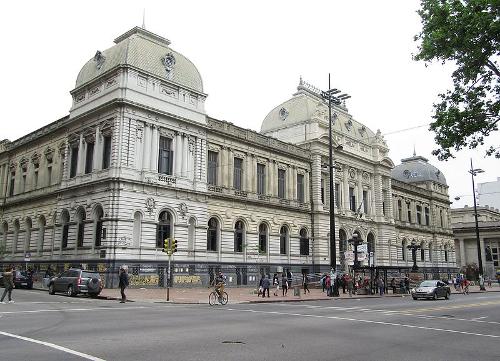URUGUAY
Society

Society
Cities in URUGUAY
| Montevideo |
Society
State structure
The Constitution of Uruguay, established in 1967, provides for an executive power of a president, a vice president and a council of ministers (approx. 12 ministers), who are appointed by the president. The legislative branch, the Asamblea General, consists of a Senate (Senado) of 30 members and a Chamber of Deputies of 99 members.
 Parliament building UruguayPhoto: Eduardo Ruggieri CC 3.0 Unported no changes made
Parliament building UruguayPhoto: Eduardo Ruggieri CC 3.0 Unported no changes made
The president, vice president and members of the assembly are elected in direct elections every five years. All Uruguayans from the age of 18 have a general obligation to vote. The elections for the president are complicated and at first glance strangely put together. Each party may nominate several members. The winner is the one with the most votes of the party with the most votes. This means that the winner almost never has the majority of the population behind him (even within their own party), and not even the candidate with the most votes in total. In eight elections between 1946 and 1984, the winning presidential candidate drew no more than 31% of the vote.
The two largest and most important parties are the progressive Partido Colorado (Colorados), with the most support in the cities, and the conservative Partido Nacional (Blancos), with the most support among the agrarian population. The Blanco party has provided president only three times since independence: 1835-1838, 1958-1967 and 1989-1994. A third, increasingly stronger party is the Frente Amplio or the Encuentro Progresista, a center-left party consisting of opposition parties that provided the mayor of Montevideo, among others. The elections of October 31, 1999 resulted in a coalition of the following parties: Colorado Party (10 seats), Blanco Party (10 seats), Frente Amplio (9 seats) and Nuevo Espacio (1 seat). For the current political situation see History.
Administrative division
 Administrative division of UruguayPhoto: Milenioscuro CC 4.0 International no changes made
Administrative division of UruguayPhoto: Milenioscuro CC 4.0 International no changes made
Administratively, Uruguay is divided into 19 departments with limited self-government headed by a governor. The departments have their own departmental legislative and administrative bodies.
Education
Uruguay was the first country in South America to have free and compulsory education. In 1877, the first education law was passed, giving all children access to education. Primary and secondary education is free and compulsory for all children up to the age of fourteen. Higher education is not free. As a result of this policy, Uruguay has the lowest illiteracy rate in South America, approximately 4%.
 Faculty of Law of the University of the Republic, UruguayPhoto: Felipe Restrepo Acosta CC 4.0 International no changes
Faculty of Law of the University of the Republic, UruguayPhoto: Felipe Restrepo Acosta CC 4.0 International no changes
Eighty percent of the workforce has at least attended primary school, 40 percent has completed secondary education and 18.5% has completed university education. For some years now, the pre-school period has also become increasingly important. At the moment, 44% of children between the ages of three and six go to the so-called “Kindergarten”. About 30% of the national budget is spent on education.
There is a state university with, among other things, a highly regarded medical faculty, an independent Roman Catholic university and a private technical education at university level, all located in Montevideo. About 70% of all university students come from Montevideo.
Sources
Bernhardson, W. / Argentina, Uruguay & Paraguay
Lonely Planet
Haitsma, M. / Uruguay: een landenmap
Novib
Jermyn, L. / Uruguay
Marshall Cavendish
CIA - World Factbook
BBC - Country Profiles
Copyright: Team The World of Info